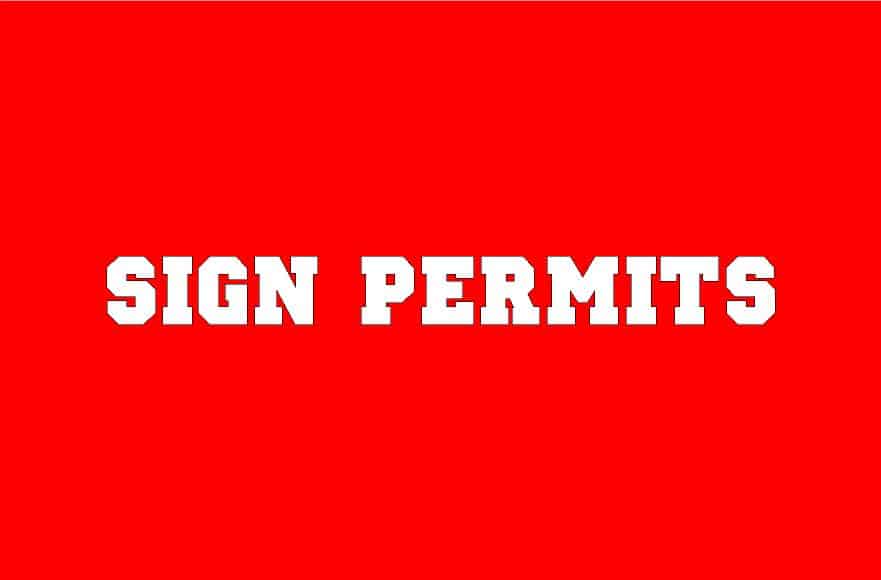You may think that a 100′ electric sign is the perfect addition to your business, but one thing may get in the way of your illuminated dream – Your local government. Exterior signs are generally regulated by your local jurisdiction, and you will most likely need their approval before installing your new sign. Simply put – You will most likely need a sign permit.
Why does my sign need to be permitted?
Sign permit regulations are put in place to ensure that signs are safe, appropriate, and in compliance with local laws. These regulations can vary significantly from one jurisdiction to another, so it’s important for businesses and organizations to understand the specific requirements in their area.
One of the main purposes of signage permit regulations is to ensure that signs are safe for the public. This includes considerations such as the stability of the sign, the materials used, and the lighting. For example, a sign that is prone to falling over, or off the building they’re mounted to, could pose a serious risk to people passing by. Electric signs that are not properly wired, can be a fire disaster waiting for happen.
In addition to safety concerns, signage permit regulations may also aim to ensure that signs are appropriate for their surroundings. This can include considerations such as the size and height of the sign, as well as the location of the sign relative to nearby buildings and landmarks. For example, a sign that is too large or that obstructs views of traffic, roads, buildings, or landmarks may be deemed inappropriate.
Code provisions related to sign permitting may also address the content of the sign, particularly in cases where the sign is being used for advertising purposes. In some cases, there may be restrictions on messaging, including the types of products or services that can be advertised, or even the language or images used. For example, certain types of advertisements such as those for tobacco, pornography, alcohol products, may be restricted in certain locations.
Sign Permit Process
Obtaining a signage permit can be a complex process, and it’s important for businesses and organizations to understand the specific requirements in their area. In general, the process may involve the following steps:
-
Determine the type of sign that is needed: There are various types of signs, including temporary signs, permanent signs, and digital signs, and each type may have different regulations. Determine the mounting mechanism – Will the sign be affixed to a building or be freestanding?
- Find out which local jurisdiction governs the sign permitting process for your property. That may be an easier task in some states than others. In Pennsylvania, there’s a cool website called Municipal Statistics, that allows you to punch in your address and it will give you the relevant jurisdiction.
-
Conduct code research of your local regulations: It’s important to understand the specific regulations that apply to the location where the sign will be installed. This may involve reviewing local ordinances or contacting the relevant local government. Once you have the correct jurisdiction, you can head over to Municode and find that jurisdiction’s code. Try searching “signage” or “Signs” to get to the relevant code section(s).
-
Submit a permit application: Once the type of sign and the local regulations have been determined, the next step is to submit a permit application. This may involve providing detailed information about the sign, including its size, materials, location, and purpose. Most local government have permit applications on their website. Some have specific “Sign Permits,” while others require you to file “Zoning” or “Building” permits (or both).
-
Pay any applicable fees: Governments don’t work for free. Be prepared to write a check to the government for reviewing your permit application. Depending on the jurisdiction, permit fees can be sizeable, and may be based on the size of the sign, the type of sign, or other factors.
-
Wait for approval: After the permit application has been submitted, the local government will review the application and make a decision. In Pennsylvania, the usually review period is 30 days. If the application is approved, the business or organization will receive a permit allowing them to proceed with the sign installation. If the application is denied, the business or organization may need to make changes to the sign or reapply.
Enforcing signage permit regulations is typically the responsibility of local regulatory agencies, such as city or county zoning or planning departments. These agencies may conduct post-installation inspections to ensure that signs are in compliance with the terms of the permit, and they may take enforcement action against businesses or organizations that fail to follow the regulations.
Can I hire someone to do this for me?
Yes! Elmark has been researching sign codes and obtaining permits for our clients since 1983. Give us a shout and tell us about your signage project.


